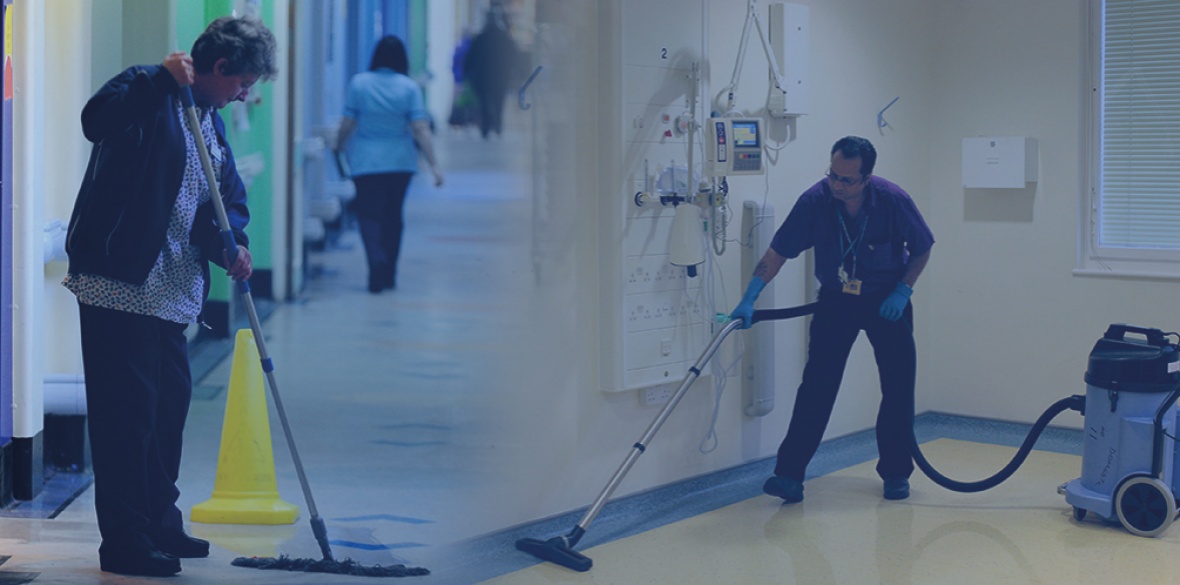This is the last article you can read this month
You can read more article this month
You can read more articles this month
Sorry your limit is up for this month
Reset on:
Please help support the Morning Star by subscribing here
HOSPITAL cleaning has taken on a new prominence in our collective consciousness. We’ve come to understand the importance of the attention to detail that cleaners practice every day. They have a crucial role: key workers who are as vital to public health as medical staff themselves.
However, in many hospitals cleaning services are contracted out. Cleaning staff are placed outside normal hospital pay and working conditions. Their vital cleaning work is divided from closely associated cleaning done by other employees like nurses, healthcare assistants and porters.
Throughout the Covid-19 pandemic, cleaners in Britain have been subject to appalling pay and conditions. In a better society, the pandemic might have resulted in improvements. As it is, it seems the increasingly privatised NHS continues to look for “technical solutions” in the form of “automated room disinfection systems.”
A 2020 review by JA Otter et al, a prominent team of scientists in the field of medical cleaning machines, analyses the efficacy and otherwise of two sorts of “automated” cleaners, against an ideological backdrop of worker replacement in hospital cleaning services.
Cleaner hospitals means less infection of vulnerable people within the institution where they are being treated. Although Covid-19 is a key factor here, with up to 9,000 people estimated to have died from Covid-19 contracted in hospital, this has always been important: the bacteria MRSA and E. coli have been particular concerns in recent decades.
The case for automating cleaning, as briefly summarised by the Otter review, is about solving the limitations in effective manual hospital cleaning.
The scientists’ assessment is worth quoting in full to understand the technical mindset: “…achieving compliance from an (often) poorly paid, poorly motivated workforce who may have limited spoken or written local language skills; inadequate training and education of personnel, inadequate time to do the job properly; insufficient (or nonexistent) cleaning prior to disinfection; incorrect formulation of the disinfectant; and contamination of cleaning solutions/materials.”
Instead of identifying a problem in employment, the team sees the solution as a technical one: simply by choosing the right robot, these problems can be eliminated. They quote one infection control expert as saying, “Given the choice of improving human behaviour, technology is the better choice.”
Papers like this are taken so seriously that they feed into Nice-accredited guidance on cleaning, which encourages the use of automated systems. This in turn has been used as justification by contracted cleaning firms to buy the machines and force their staff to use them.
So what is this new technology?
There are two sorts of machines: HPV (hydrogen peroxide vapour) and UV (ultraviolet) cleaners. These two types of cleaning robot work have very little in common but are sold by the same suppliers and touted as the solution to hospital cleaning.
HPV machines vaporise hydrogen peroxide, a strong poison. They are left in an airtight evacuated ward or room and fill the entire space with a “fog” of disinfectant. The vapour covers every surface and penetrates porous surfaces. The room must be left for a few hours while the fog dissipates.
The UV machines also work in an evacuated ward, because they use a powerful UV light. The light is shone brightly throughout the room. The UV light damages bacterial and viral genetic material and if applied strongly enough will totally destroy the genetic function.
Unlike the HPV machines, the ward does not need to be hermetically sealed to stop the poison leaking out, making it easier to control. The UV light only cleans surfaces with a direct line of sight to the machine so it doesn’t clean anything in shadow. All surfaces must be manually cleaned before using the UV.
On the face of it, these are exciting new technological developments. Aren’t we seeing the direct application of hi-tech scientific ideas to keep everyone in hospital healthier? The UV-cleaning machine especially is excitingly sci-fi.
In practice, the machines seem to be a bit murkier.
There are a number of problems with the machines. They are not in fact “automated cleaning,” but are tools to be used by cleaning staff. The HPV machines require the wholesale evacuation of patients and staff from the area to be cleaned over an extended period. They also require perfectly airtight rooms to prevent leakage of the poison, which at a time of concerns over ventilation in hospitals is a significant consideration.
In Morriston Hospital, Swansea, HPV machines were introduced in 2014, but staff were not given adequate PPE or training. Several were subsequently exposed to poisonous vapour which caused severe respiratory illness.
They won the legal challenge they brought, and were awarded compensation. The legal firm that represented the workers continues to seek claimants among the thousands of NHS workers who have been similarly exposed. In Morriston hospital, the machines were taken out of operation in 2016, after just two years.
The efficacy of the machines is also questioned by the Otter review, which cites conflicting published data on whether HPV machines are effective against MRSA. Although it cites positive results for the UV machines, the review notes that studies often implement multiple interventions at the same time to improve cleaning, making the impact of the UV machines alone difficult to disentangle.
In a properly funded hospital, where the wards were properly insulated from each other with adequate bed capacity, alongside multiple other interventions, these HPV and UV machines might be an excellent aid to cleaning. In the actually existing NHS, it seems that the machines are an expensive snake oil bought by contractors to impress NHS management and win contracts.
Activists at Greenwich Keep Our NHS Public supporting the GMB branch of cleaners at Lewisham Hospital suspect an emphasis on the new machines was responsible for the awarding of the latest hospital cleaning contract to the company ISS.
As part of the tender, the firm promised to invest in new HPV and UV cleaning machines. In April 2021 they cut 495 hours from cleaners’ contracts, sending cleaners out to protest.
This mentality of replacing cleaning staff with machines even runs contrary to a major supplier of the machines. Inivos stress on their website that, “Neither UV-C or HPV decontamination systems are intended to replace manual cleaning, but rather should be used as a complementary method to create a safer environment.”
The solely “technical solution” is a fantasy. There is only one way to improve hospital hygiene. By increasing their skills, pay and conditions and also their access to and understanding of hi-tech tools, cleaners will be able to improve decontamination of hospitals themselves.











